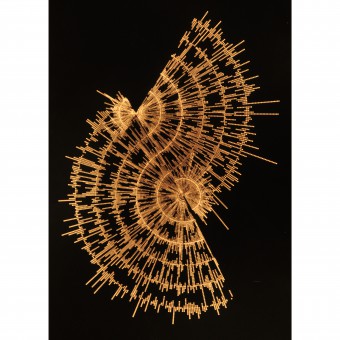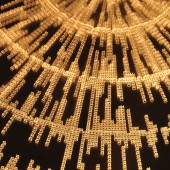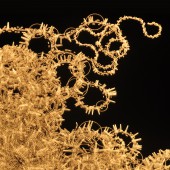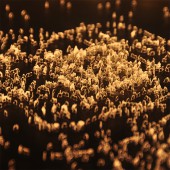
| THE AWARD |
| CATEGORIES |
| REGISTRATION |
| SUBMIT YOUR WORK |
| ENTRY INSTRUCTIONS |
| TERMS & CONDITIONS |
| PUBLICATIONS |
| DATES & FEES |
| METHODOLOGY |
| CONTACT |
| WINNERS |
| PRESS ROOM |
| GET INVOLVED |
| DESIGN PRIZE |
| DESIGN STORE |
| THE AWARD | JURY | CATEGORIES | REGISTRATION | PRESS | WINNERS | PUBLICATIONS | ENTRY INSTRUCTIONS |
Crystals Art Installation by YINGRI GUAN |
Home > Winners > Design #103298 >Interview |
 |
|
FS: What is the main principle, idea and inspiration behind your design?
YG: The main inspiration behind this series of crystal visualizations is the generative formation pattern in different crystals. Crystals share the same properties as fractals where they are formed by repetitively using the same unit, and hence fractals are used to represent four different crystals in this series of works.
FS: What has been your main focus in designing this work? Especially what did you want to achieve?
YG: My main focus in designing this work is to explore. I wanted to see what it could be if I am able to combine mathematical formulas, crystal data information, design and art could create.
FS: What are your future plans for this award winning design?
YG: I plan to utilize the same method of creation for this series of works and apply to another similar naturally occurring phenomenon to create visualizations that could bring some unique alternative reality.
FS: How long did it take you to design this particular concept?
YG: The design took about 1 month. Implementation took long because laser cutter and other facilities are required to make some of the items.
FS: Why did you design this particular concept? Was this design commissioned or did you decide to pursuit an inspiration?
YG: I designed this particular concept out of personal curiosity. I wanted to explore ways of visualization. Also explore ways of combining multi disciplines to push the boundaries in design and art.
FS: Is your design being produced or used by another company, or do you plan to sell or lease the production rights or do you intent to produce your work yourself?
YG: I intend to sell these products myself for now. If future opportunities prevail and I could have the opportunity of putting these into the mass market, I'd access the suitability based on my values.
FS: What made you design this particular type of work?
YG: I designed this particular type of work as a product of explorations. Out of curiosity and personal interest, it pushed me to see where this experimentation could go.
FS: Where there any other designs and/or designers that helped the influence the design of your work?
YG: My professors were my consultants in this work and they have provided valuable feedback. But most of the implementation is done by me.
FS: Who is the target customer for his design?
YG: The target customer is the relatively wealthy audiences who are into collecting new and unique artworks that push the boundaries of design, art, science, and mathematics. Who are open-minded and open to new explorations in the art world.
FS: What sets this design apart from other similar or resembling concepts?
YG: This design is different from other similar resembling concepts in that this combines the digital production with physical materials to form physical visualizations which my audience is not only able to have visual enjoyment of the art but also having textual and interactive sensations that help them understand the work.
FS: How did you come up with the name for this design? What does it mean?
YG: The name is quite straight forward. It represents the original inspiration as well as what the end product is visualizing.
FS: Which design tools did you use when you were working on this project?
YG: I have used processing, adobe creative suite, laser cutting, and wood saw for this project.
FS: What is the most unique aspect of your design?
YG: The most unique aspect of my design is the goal of providing an alternative reality to my audience through physical visualization.
FS: Who did you collaborate with for this design? Did you work with people with technical / specialized skills?
YG: I did work with lab technicians in terms of how to set up laser cutter files, how the different materials would behave as well as gotten help in terms of producing the frame to install these pieces.
FS: What is the role of technology in this particular design?
YG: Technology is integral to this design. It is involved in every process of the production of this piece. From the initial ideation, research, to gradual iterations and finally the production of the design, technology is involved in every step along the way and indeed the driving force for this particular design.
FS: Is your design influenced by data or analytical research in any way? What kind of research did you conduct for making this design?
YG: Yes, the design is influenced by data or analytical research. I did conduct research about the formation of crystals. How fractals in mathematics would work and finally ways to represent crystals by using fractals.
FS: What are some of the challenges you faced during the design/realization of your concept?
YG: The main challenges are the translation from digital concepts and imagery to physical visualizations.
FS: How did you decide to submit your design to an international design competition?
YG: I decided to submit to A'Design competition as I saw the call for art online and thought how cool would it be if I could have some recognitions in this international award. I am truly grateful I was given a reward for the work I have done.
FS: What did you learn or how did you improve yourself during the designing of this work?
YG: I have learned that design is mostly about confronting limitations. I ran into a lot of limitations when working on this project. Each time, I'd come up with creative ways to solve the problems. Hence that really stretch my imagination and expand my skills.
FS: Any other things you would like to cover that have not been covered in these questions?
YG: I'd love to hear any feedback from you. Feel free to share with me your thoughts about design, my work or things in general at yingriguan@gmail.com.
FS: Thank you for providing us with this opportunity to interview you.
A' Design Award and Competitions grants rights to press members and bloggers to use parts of this interview. This interview is provided as it is; DesignPRWire and A' Design Award and Competitions cannot be held responsible for the answers given by participating designers.
| SOCIAL |
| + Add to Likes / Favorites | Send to My Email | Comment | View Press-Release | Translations |




